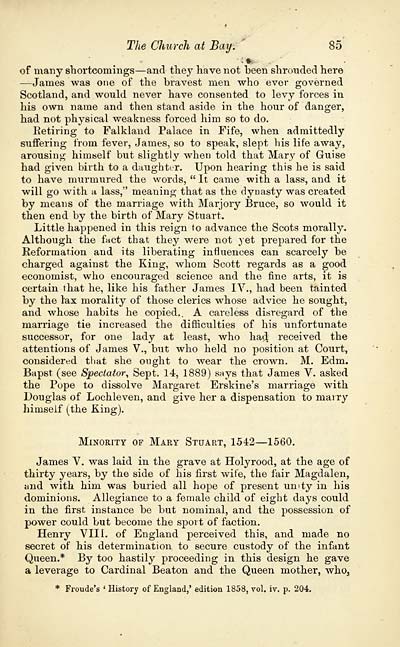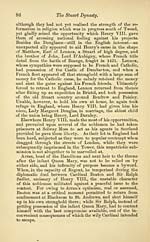Stuart dynasty
(105) Page 85 - Minority of Mary Stuart, 1542-1560
Download files
Complete book:
Individual page:
Thumbnail gallery: Grid view | List view

The Church at Bay. 85
■ . »,
of many shortcomings — and they have not been shrouded here
— James was one of the bravest men who ever governed
Scotland, and would never have consented to levy forces in
his own name and then stand aside in the hour of danger,
had not physical weakness forced him so to do.
Eetiring to Falkland Palace in Fife, when admittedly
suffering from fever, James, so to speak, slept bis life away,
arousing himself but slightly when told that Mary of Guise
had given birth to a daughter. Upon hearing this he is said
to have murmured the words, " It came with a lass, and it
will go with a lass," meaning that as the dynasty was created
by means of the marriage with Marjory Bruce, so would it
then end by the birth of Mary Stuart.
Little happened in this reign to advance the Scots morally.
Although the fact that they were not yet prepared for the
Reformation and its liberating influences can scarcely be
charged against the King, whom Scott regards as a good
economist, who encouraged science and the fine arts, it is
certain that he, like his father James IV., had been tainted
by the lax morality of those clerics whose advice he sought,
and whose habits he copied.. A careless disregard of the
marriage tie increased the difficulties of his unfortunate
successor, for one lady at least, who had received the
attentions of James V., but who held no position at Court,
considered that she ought to wear the crown. M. Edm.
Bapst (see Spectator, Sept. 14, 1889) snys that James V. asked
the Pope to dissolve Margaret Erskine's marriage with
Douglas of Lochleven, and give her a dispensation to marry
himself (the King).
Minority of Mary Stuart, 1542 — 1560.
James V. was laid in the grave at Holyrood, at the age of
thirty years, by the side of his first wife, the fair Magdalen,
and with him was buried all hope of present unity in his
dominions. Allegiance to a female child of eight days could
in the first instance be but nominal, and the possession of
power could but become the sport of faction.
Henry VIII. of England perceived this, and made no
secret of his determination to secure custody of the infant
Queen.* By too hastily proceeding in this design he gave
a leverage to Cardinal Beaton and the Queen mother, who,
* Froude's ' History of England,' edition 1858, vol. iv. p. 204.
■ . »,
of many shortcomings — and they have not been shrouded here
— James was one of the bravest men who ever governed
Scotland, and would never have consented to levy forces in
his own name and then stand aside in the hour of danger,
had not physical weakness forced him so to do.
Eetiring to Falkland Palace in Fife, when admittedly
suffering from fever, James, so to speak, slept bis life away,
arousing himself but slightly when told that Mary of Guise
had given birth to a daughter. Upon hearing this he is said
to have murmured the words, " It came with a lass, and it
will go with a lass," meaning that as the dynasty was created
by means of the marriage with Marjory Bruce, so would it
then end by the birth of Mary Stuart.
Little happened in this reign to advance the Scots morally.
Although the fact that they were not yet prepared for the
Reformation and its liberating influences can scarcely be
charged against the King, whom Scott regards as a good
economist, who encouraged science and the fine arts, it is
certain that he, like his father James IV., had been tainted
by the lax morality of those clerics whose advice he sought,
and whose habits he copied.. A careless disregard of the
marriage tie increased the difficulties of his unfortunate
successor, for one lady at least, who had received the
attentions of James V., but who held no position at Court,
considered that she ought to wear the crown. M. Edm.
Bapst (see Spectator, Sept. 14, 1889) snys that James V. asked
the Pope to dissolve Margaret Erskine's marriage with
Douglas of Lochleven, and give her a dispensation to marry
himself (the King).
Minority of Mary Stuart, 1542 — 1560.
James V. was laid in the grave at Holyrood, at the age of
thirty years, by the side of his first wife, the fair Magdalen,
and with him was buried all hope of present unity in his
dominions. Allegiance to a female child of eight days could
in the first instance be but nominal, and the possession of
power could but become the sport of faction.
Henry VIII. of England perceived this, and made no
secret of his determination to secure custody of the infant
Queen.* By too hastily proceeding in this design he gave
a leverage to Cardinal Beaton and the Queen mother, who,
* Froude's ' History of England,' edition 1858, vol. iv. p. 204.
Set display mode to:
![]() Universal Viewer |
Universal Viewer | ![]() Mirador |
Large image | Transcription
Mirador |
Large image | Transcription
Images and transcriptions on this page, including medium image downloads, may be used under the Creative Commons Attribution 4.0 International Licence unless otherwise stated. ![]()
| Histories of Scottish families > Stuart dynasty > (105) Page 85 - Minority of Mary Stuart, 1542-1560 |
|---|
| Permanent URL | https://digital.nls.uk/94819026 |
|---|
| Description | A selection of almost 400 printed items relating to the history of Scottish families, mostly dating from the 19th and early 20th centuries. Includes memoirs, genealogies and clan histories, with a few produced by emigrant families. The earliest family history goes back to AD 916. |
|---|

